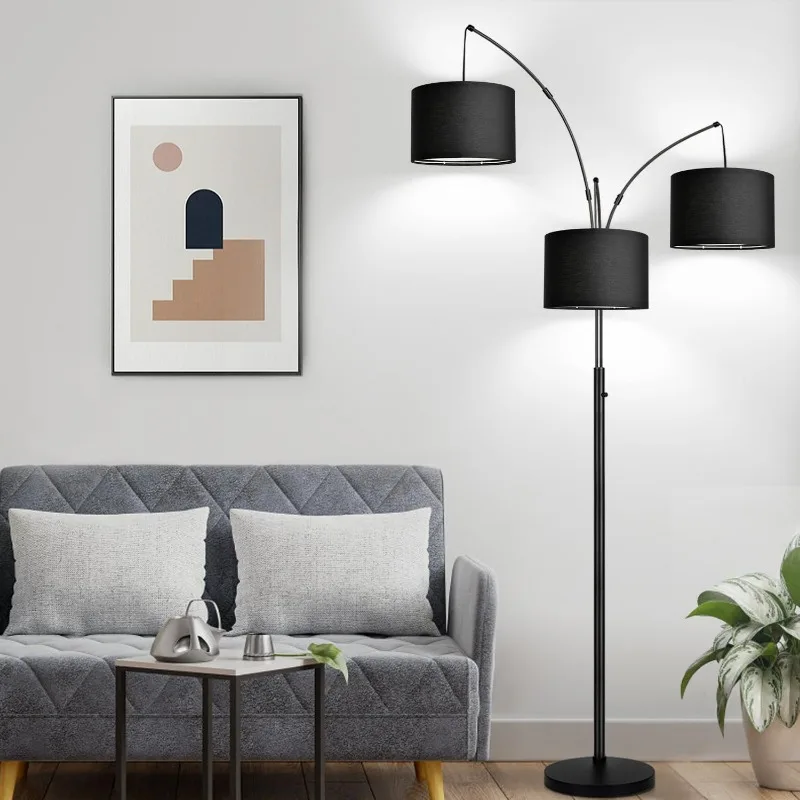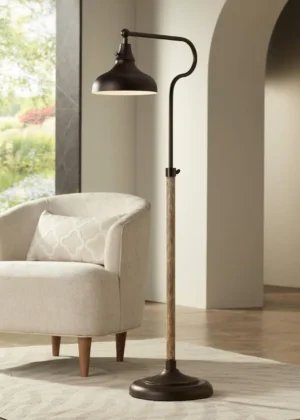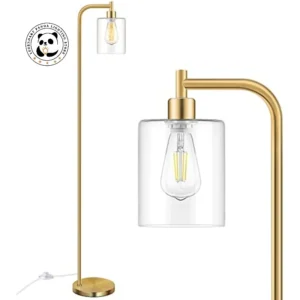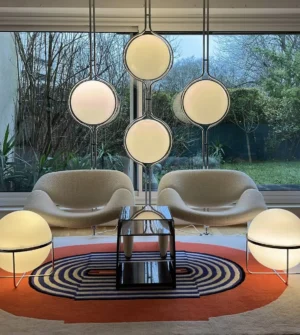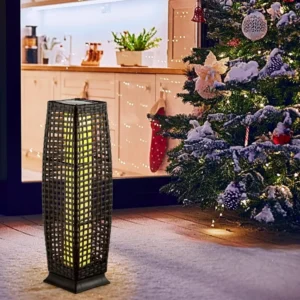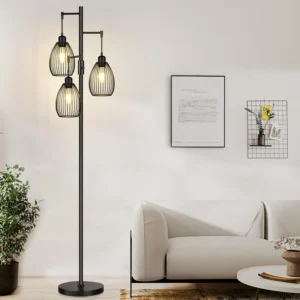Introduction: Untangle Your Space: Why Floor Lamp Cable Management Matters
Walking into a beautifully decorated room only to trip over an exposed floor lamp cord can instantly ruin the atmosphere you’ve worked so hard to create. Beyond being eyesores, unmanaged lamp cables create real safety hazards in our homes and offices. These tangled messes not only disrupt the visual flow of your space but can lead to accidents, damaged cords, and unnecessary stress.
Floor lamp cable management requires special attention because these lamps often sit in prominent positions, with cords that must travel across open floor space to reach outlets. Unlike desk lamps or wall-mounted fixtures, floor lamps create unique challenges that demand tailored solutions.
Taking the time to manage your floor lamp cables offers numerous benefits:
- Enhanced safety: Reduces tripping hazards and potential fire risks from damaged cords
- Improved aesthetics: Creates a cleaner, more sophisticated look in any room
- Extended cable life: Prevents wear and tear from foot traffic or furniture movement
- Peace of mind: Eliminates the constant visual reminder of disorganization
In this comprehensive guide, we’ll explore various tools and techniques for taming those unruly floor lamp cables. From simple concealment options to creative decorative approaches, you’ll discover solutions that match your specific needs and style preferences. Understanding the basics of choosing the perfect arc floor lamp provides valuable context for managing their cables effectively.
According to home safety experts, nearly 4,000 injuries occur annually from tripping over household cords and cables. With the right tools and techniques, your floor lamp can add beauty to your space without adding risk.
Key Considerations Before Choosing Your Cable Management Solution
Before diving into specific tools and products, take time to assess your unique situation. The right cable management approach depends on several important factors:
Location and Visibility
Where your lamp stands determines which solutions make sense. Is your lamp against a wall or in the center of a room? Does the cord need to cross high-traffic areas? Lamps in the middle of rooms present different challenges than those tucked into corners.
Cable Quantity and Thickness
Are you managing just one lamp cord, or do you need to organize multiple cables from other devices too? Modern floor lamps might include thicker adapter cables or even multiple cords for smart features, requiring different management approaches than slim, standard cables.
Aesthetic Preferences
Some people want cables completely invisible, while others might embrace them as design elements. Your personal style will guide whether you conceal, organize, or decorate your cords.
Surface Compatibility
Different solutions work better on different flooring types. Adhesive-based options that perform well on hardwood might fail on carpet. Similarly, solutions for tiled floors may not work on delicate wood surfaces that could be damaged.
Budget Planning
Cable management solutions range from nearly free DIY approaches to premium systems costing $50 or more. Setting a budget helps narrow your options to what makes sense for your situation.
Flexibility Needs
How often do you rearrange your furniture? If you frequently redecorate, you’ll want easily removable, flexible solutions rather than permanent installations.
Safety Priorities
Households with young children or pets need extra-secure solutions that prevent tugging, chewing, or playing with cords. Understanding how to hide arc floor lamp cords becomes especially important in these situations.
Before shopping, take a few minutes to assess your specific needs across these categories. This small investment of time will guide you toward solutions that truly work for your home, rather than quick fixes that might create new problems.
Physical Concealment Solutions: Making Lamp Cables Disappear
When your goal is to make unsightly lamp cables virtually invisible, these physical concealment options offer the most comprehensive solutions:
Cord Covers & Raceways
Cord covers are channel-like devices that completely encase your cables, providing both protection and visual concealment. They come in several varieties:
- Floor cord covers: Flat, low-profile channels that adhere to hard floors and create a smooth transition over cables
- Wall-mounted raceways: Vertical or horizontal channels that attach to baseboards or walls to carry cords upward or across
- Corner duct covers: Specialized covers designed to work in room corners where cables often run
Most cord covers can be painted to match your walls or floors, further reducing their visibility. Installation typically involves either adhesive backing or small screws, depending on the model.
Pros:
– Complete concealment of cables
– Additional physical protection from foot traffic
– Available in various sizes to accommodate multiple or thick cables
– Professional appearance when properly installed
Cons:
– More permanent than some alternatives
– May require cutting to fit specific lengths
– Some models can be challenging to access when needing to add or remove cables
Cable Management Boxes
For areas where multiple cables converge—often near outlets—cable management boxes provide an elegant solution:
- Power strip enclosures: Boxes designed to hold entire power strips and excess cord length
- Cable junction boxes: Smaller options for organizing cable intersections
- Decorative options: Boxes designed to complement your décor rather than just hide cables
Proper placement is key, typically near the lamp base or outlet. Most boxes include ventilation features to prevent overheating of adapters or transformers inside.
Pros:
– Hides multiple cables and power strips in one container
– Reduces dust accumulation on electrical components
– Creates a clean look near wall outlets
– Many designs complement home décor
Cons:
– Requires sufficient floor space for placement
– Limited capacity depending on size
– May not work well with very large adapters
Cable Sleeves & Wraps
For a more flexible approach to cable concealment, sleeves and wraps bundle cables together while hiding them in a protective cover:
- Fabric sleeves: Soft, flexible covers that zip or velcro around cables
- Neoprene wraps: Durable, water-resistant options ideal for high-traffic areas
- Spiral cable wrap: Allows cables to exit at any point along the cover’s length
For floor lamps, look for sleeves in appropriate diameters (typically 0.5-1 inch) and lengths that accommodate the distance from lamp to outlet. Many brands offer various colors to match your décor or floor color.
Following proper cord organization tips for arc lamps will help you maximize the effectiveness of these concealment tools.
Pros:
– Extremely flexible and adaptable to various situations
– Easy to install without tools
– Can be cut to custom lengths
– Available in multiple colors and materials
Cons:
– Less rigid protection than hard covers
– May shift position over time
– Some models attract dust or lint
When selecting physical concealment solutions, consider the visibility level of your lamp’s placement. Prominent locations might justify investing in higher-quality, more aesthetic options, while simple solutions work well for less visible areas.
Securing & Routing Tools: Keeping Lamp Cords Organized and Safe
While complete concealment isn’t always necessary or practical, properly securing and routing your lamp cables can dramatically improve both safety and appearance. These tools help direct cables along specific paths while keeping them firmly in place:
Adhesive Cable Clips & Clamps
These small but mighty tools secure cables to walls, furniture, or baseboards at strategic points:
- Individual cable clips: Small clips that hold single cables in place
- Multi-cable organizers: Larger clips that can route several cables side by side
- Decorative clips: Designer options that add visual interest while organizing
For floor lamps, place clips strategically to guide cables along baseboards or furniture edges. Choose appropriate clip sizes based on your cord diameter—most lamp cords fit in 3-5mm clips.
Application Tips:
– Clean surfaces thoroughly before applying adhesive clips
– Space clips every 12-18 inches for optimal support
– Consider clear clips for maximum invisibility
– Use rubbing alcohol to remove adhesive residue when repositioning
Cable Ties & Straps
Perfect for bundling excess cord length or securing cables to lamp stands:
- Reusable velcro wraps: Adjustable, removable options ideal for changing setups
- Zip ties with mounting holes: Secure options that can be attached to surfaces
- Decorative ties: Leather or fabric options that look intentional rather than utilitarian
Application Tips:
– Avoid overtightening, which can damage cable insulation
– Create a small loop near the outlet to prevent stress on plugs
– Use color-coordinated ties when visible for a more cohesive look
– Bundle excess cable near the lamp base rather than mid-run
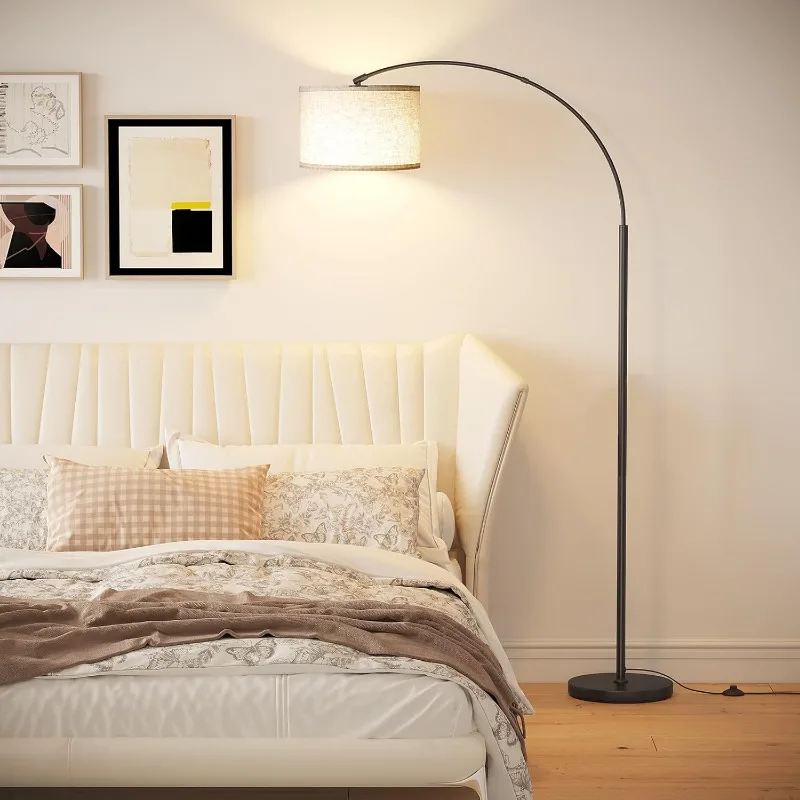
Removable Command Hooks & Strips
These versatile adhesive products create custom routing solutions for lamp cables:
- Small cord clips: Designed specifically for lightweight cables
- Decorative hooks: Larger options that can make cable routing look intentional
- Clear hooks: Nearly invisible options for maximum discretion
Application Tips:
– Follow weight limit guidelines precisely
– Space hooks 6-12 inches apart for gentle curves
– Create straight runs whenever possible to minimize visibility
– Allow adhesive to set for the recommended time before adding cables
Many customers find that adjustable arc floor lamps offer more flexibility for positioning relative to outlets, potentially reducing cable management challenges.
When implementing these securing tools, think about maintenance and flexibility. If you frequently rearrange your space, opt for easily removable solutions like command strips or velcro ties rather than more permanent clips or adhesives.
For lamps near seating areas, focus on both securing and protecting cords from foot traffic. A combination approach—using cord covers for floor areas and discrete clips for vertical runs—often provides the best results for complex layouts.
Creative & Decorative Solutions: Making Lamp Cables Part of Your Design
Instead of hiding cables, sometimes embracing them as design elements can transform a necessity into an asset. These creative approaches turn utilitarian lamp cords into deliberate decorative features:
Decorative Cable Transformations
With a bit of creativity, standard black or white cords become custom design elements:
- Rope wrapping: Covering cords with colorful rope or twine creates texture and visual interest
- Fabric cord covers: Custom sleeves made from decorative fabrics that complement your décor
- Washi tape accents: Simple tape designs that add color patterns to otherwise plain cords
When transforming cables decoratively, ensure any materials used are non-conductive and won’t generate heat. Leave plugs and connection points accessible and avoid covering ventilation areas on adapters or transformers.
Strategic Furniture Placement
Sometimes the best cable management doesn’t require additional tools at all:
- Position bookcases or console tables to create natural pathways for cables
- Use furniture legs as anchor points for cable routing
- Place small decorative objects (like potted plants) to mask cable exits from behind furniture
The key is planning your furniture layout with cable paths in mind, rather than treating them as an afterthought. Understanding what to look for in arc floor lamps helps you select models that work best with your furniture arrangement.
Area Rugs & Floor Coverings
Strategic use of floor coverings can elegantly conceal lamp cables:
- Run flat cables under area rugs along low-traffic edges
- Use runner rugs to create cable channels between furniture pieces
- Select rugs with patterns that would make any visible cord less noticeable
Important Safety Note: Only run proper flat cables under rugs, never standard rounded cables which could create tripping hazards or become damaged under foot traffic.
These decorative approaches work particularly well in rental properties where permanent solutions aren’t possible or in design-forward spaces where every element should contribute to the overall aesthetic. The best decorative solutions acknowledge cables rather than trying to make them invisible, incorporating them thoughtfully into your design scheme.
Advanced & Specialty Cable Management Options for Floor Lamps
For those seeking the ultimate in cable management or dealing with particularly challenging situations, these advanced options provide comprehensive solutions:
In-Wall Cable Routing Systems
For permanent lamp placements, in-wall solutions create the cleanest possible look:
- Recessed cable channels: Create paths inside walls for completely hidden cable runs
- Power bridge kits: Systems that allow power to be extended from one outlet location to another behind walls
- Wall plates with brush openings: Professional-looking exits for cables emerging from walls
These solutions typically require basic to moderate DIY skills and tools like drywall saws and wire detectors. For renters or those uncomfortable with wall modifications, stick with less invasive options.
Furniture with Integrated Cable Management
Modern furniture designers increasingly recognize the need for cable management:
- End tables with hidden channels and outlet access
- Floor lamp bases with integrated cord storage
- Sofa and chair designs with spaces for running cables underneath
While more expensive than standalone solutions, furniture with built-in cable management provides the most seamless integration, particularly valuable for prominent room placements.
Cordless & Rechargeable Floor Lamps
The ultimate cable management solution eliminates cables entirely:
- Battery-operated lamps with extended run times
- Rechargeable models with discreet charging ports
- Solar-powered options for spaces with adequate natural light
LED arc floor lamps often feature more efficient power usage, allowing for longer battery life in cordless models. While typically more expensive upfront, these solutions eliminate ongoing cable management concerns entirely.
When considering advanced options, weigh the long-term benefits against initial investment costs. For long-term living situations or particularly problematic cable arrangements, more permanent solutions often provide better value despite higher initial costs.
Best Practices for Safe & Effective Floor Lamp Cable Management
Whatever specific tools you choose, following these best practices ensures optimal safety and effectiveness:
Comprehensive Planning Approach
- Map your entire room before implementing solutions, identifying all power sources and optimal lamp placements
- Measure cable distances accurately to purchase appropriate length management tools
- Consider future needs like additional lamps or seasonal decorations that might affect your setup
- Plan for accessibility to ensure you can still easily unplug lamps when needed
Taking time to plan comprehensively prevents wasted purchases and ensures your solutions work together as a system rather than as disconnected fixes.
Electrical Safety Guidelines
- Never overload outlets with multiple high-wattage lamps
- Inspect cables regularly for signs of wear, especially at connection points
- Use surge protectors for valuable lamps with electronic components
- Avoid running cables under heavy furniture which could damage insulation over time
- Keep connections away from water sources and high-moisture areas
Remember that cable management isn’t just about appearance—it’s fundamentally about creating a safer environment.
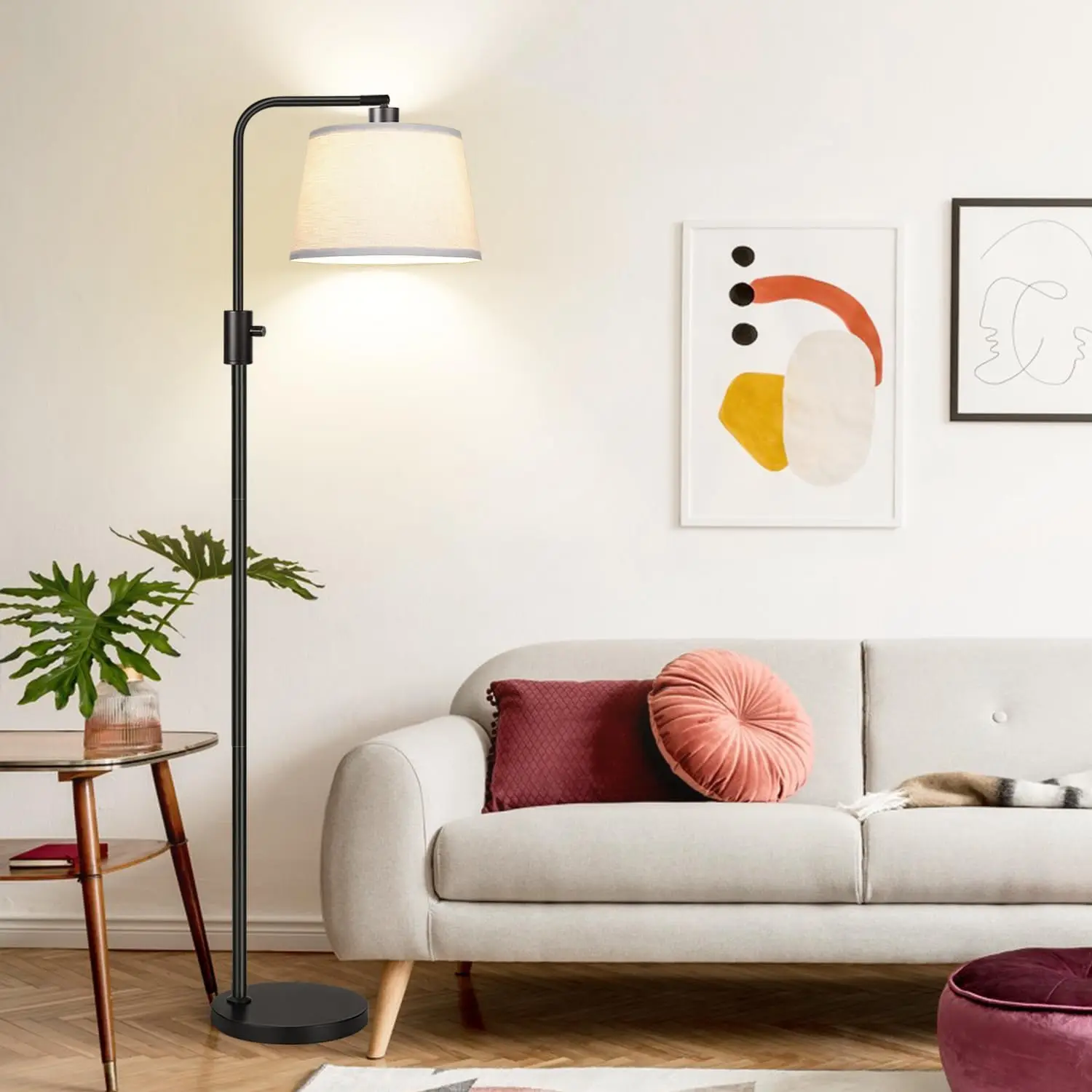
Maintenance Routines
- Schedule quarterly inspections of all cable management systems
- Clean dust from covers and channels to prevent buildup
- Check adhesive components for signs of loosening
- Replace damaged or worn elements promptly before they fail
Regular maintenance extends the life of both your management solutions and the lamp cables themselves.
Child and Pet Safety Measures
- Use cord covers with difficult-to-open designs for homes with curious children
- Apply pet-safe bitter sprays to deter chewing on exposed sections
- Secure excess cable length well out of reach of little hands and paws
- Choose heavy-duty solutions that can withstand tugging or playing
Dimmable arc floor lamps with properly managed cables provide both safety and ambiance control, creating comfortable spaces for families with young children.
By implementing these best practices alongside your chosen management tools, you create not just a better-looking space but a safer, more functional environment for everyone in your home.
DIY Cable Management Solutions for Budget-Conscious Lamp Owners
Not every effective cable management solution requires a special purchase. These creative DIY approaches use common household items to tame unruly lamp cords:
Repurposed Household Items
Transform objects you already have into effective cable management tools:
- Binder clips clamped to desk edges create perfect cable-routing points
- Toilet paper or paper towel tubes split lengthwise become instant cable covers
- Old credit cards cut into strips with notches make custom cable clips
- Decorative ribbon or string wraps cords for a custom look
These solutions cost almost nothing but can be surprisingly effective for basic cable control needs.
Simple No-Tool Projects
These quick projects require minimal crafting skills but deliver impressive results:
DIY Fabric Cord Cover:
– Materials: Fabric scraps, velcro strips, scissors
– Simply cut fabric into a long strip, fold over cord, and secure with velcro dots
Paperclip Cable Guides:
– Materials: Colorful large paperclips, double-sided tape
– Bend paperclips slightly, attach to surfaces with tape, and thread cables through
Shoebox Cable Organizer:
– Materials: Shoebox, utility knife, decorative paper
– Cut holes for cables, decorate box exterior, place near outlet to hide power strips
These projects typically cost under $5 and can be completed in under 30 minutes, making them perfect weekend solutions.
When considering DIY versus commercial options, arc floor lamps with their distinctive shapes often benefit from more customized cable management approaches that address their unique configurations.
Cost Comparison
| Solution Type | DIY Cost | Commercial Cost | Best For |
|---|---|---|---|
| Cable Covers | $2-5 | $10-25 | Long cable runs |
| Cable Organizers | $0-3 | $8-15 | Multiple cables |
| Decorative Wraps | $1-4 | $12-20 | Visible cables |
| Storage Boxes | $0-5 | $15-30 | Power strip areas |
While DIY solutions save money, consider investing in commercial products for high-traffic areas or situations where safety is particularly important.
Adjustable Arc Floor Lamp, Bronze Arc Floor Lamp
Price range: $440.95 through $558.52 Select options This product has multiple variants. The options may be chosen on the product pageBrass Arc Floor Lamp, Contemporary Arc Floor Lamp, LED Arc Floor Lamp
Price range: $490.72 through $522.04 Select options This product has multiple variants. The options may be chosen on the product pageChrome Arc Floor Lamp, LED Arc Floor Lamp
Price range: $304.95 through $1,210.40 Select options This product has multiple variants. The options may be chosen on the product pageLED Arc Floor Lamp, Rattan Arc Floor Lamp
$313.58 Select options This product has multiple variants. The options may be chosen on the product page3 Light Arc Floor Lamp, Dimmable Arc Floor Lamp
Price range: $162.86 through $246.50 Select options This product has multiple variants. The options may be chosen on the product pageLED Arc Floor Lamp, Retro Arc Lamp
$1,175.07 Select options This product has multiple variants. The options may be chosen on the product page
Lamp Cable Management for Special Situations and Challenges
Some living situations present unique cable management challenges that require specialized approaches:
Rental Property Constraints
When you can’t make permanent modifications, try these renter-friendly solutions:
- Removable adhesive products that won’t damage paint or surfaces
- Tension rods between floors and ceilings to create vertical cable runs
- Furniture-based routing that requires no wall attachments
- Decorative baskets strategically placed to hide cable bundles
Focus on solutions that can be completely removed without a trace when your lease ends.
Historic Homes with Limited Outlets
Older homes often have insufficient outlets for modern lighting needs:
- Extension cord concealment systems designed for longer runs
- Period-appropriate cord covers that complement historic details
- Decorative cord management that transforms necessity into period-appropriate detail
- Strategic furniture placement to minimize visible cable lengths
Balance modern functionality with respect for architectural character when managing cables in historic spaces.
Open Floor Plans
Open concepts create particular challenges for floor lamps placed away from walls:
- Under-rug cable channels designed specifically for flat, low-profile installation
- Floor-based cord covers in colors matching your flooring
- Central furniture islands that provide cable pathways to wall outlets
- Decorative floor patterns that visually camouflage necessary cable runs
In open spaces, consider how to secure tall floor lamps properly, as both the lamp stability and cable management work together to create a safe setup.
The key to managing cables in challenging situations is adapting standard solutions to your specific constraints while maintaining safety as the top priority.
Can You Use the Same Cable Management Tools for All Types of Floor Lamps?
Different floor lamp styles present unique cable management challenges and opportunities. Understanding these differences helps you select the most appropriate solutions:
| Lamp Style | Cable Challenges | Best Management Solutions |
|---|---|---|
| Arc Floor Lamps | Long reach from base to outlet, visible suspended cables | Cable sleeves, floor cord covers, decorative wrapping |
| Traditional Pole Lamps | Straight vertical cables, potential trip hazards | Clips along pole, baseboard routing, furniture positioning |
| Tree Floor Lamps | Multiple cables from several light sources | Cable bundling wraps, cord consolidators, larger covers |
| Torchiere Lamps | Often placed in corners with visible wall cables | Wall-mounted clips, corner cable channels, painted cord covers |
| Adjustable Lamps | Moving parts require flexible cable management | Extra slack allowance, spiral wraps, flexible sleeves |
The thickness of the cable also impacts which management tools work best. Many black arc floor lamps come with thicker cables that require larger-diameter management solutions than standard cords.
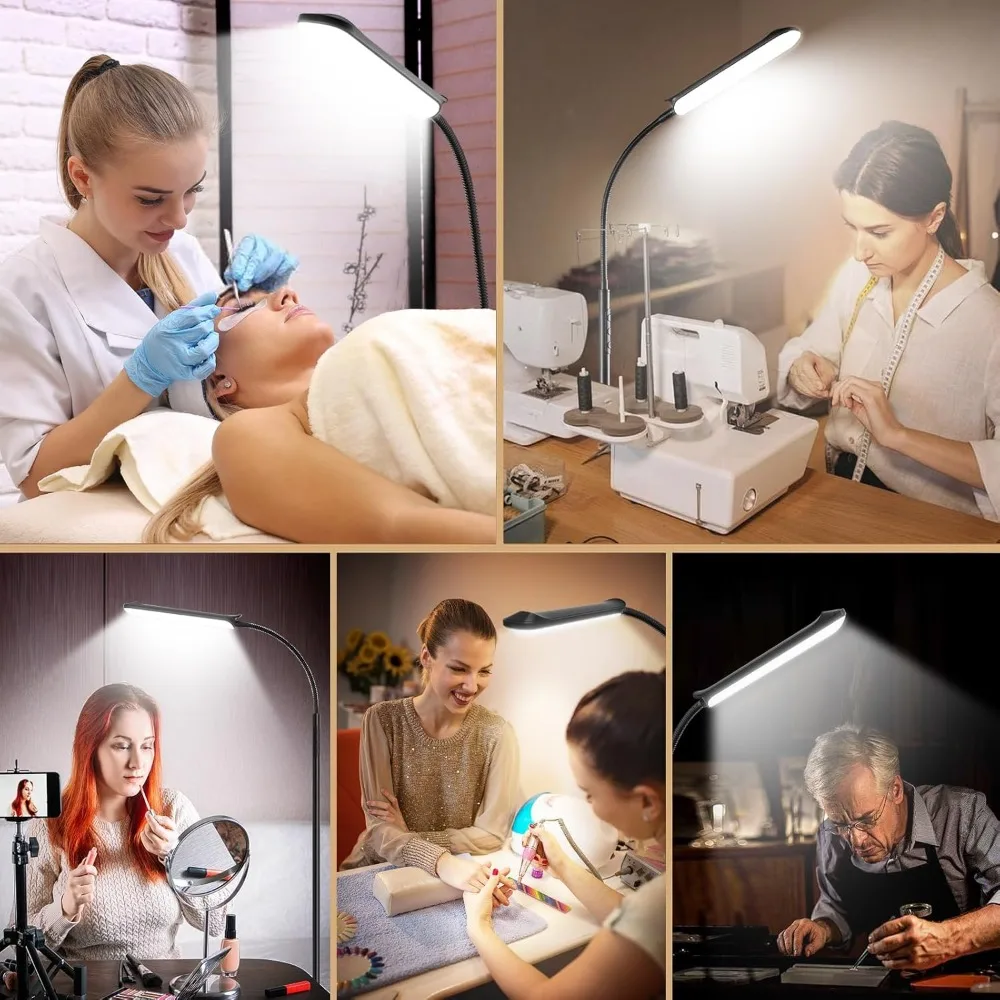
When choosing management tools, always check the maximum cable diameter they can accommodate. Attempting to force thick cables into undersized management tools can damage both the cable and the tool.
For articulating or adjustable lamps, ensure your management solution provides adequate flexibility for all possible positions without straining the cable.
How Have Smart Floor Lamps Changed Cable Management Needs?
The rise of smart home technology has introduced new cable management challenges for modern floor lamps:
Smart floor lamps often include additional cables beyond the standard power cord:
– Transformer boxes or power adapters that need concealment
– Thicker cables to accommodate additional power or data connections
– Secondary connections for USB charging ports or other features
Managing these components requires special consideration:
– Larger cable management boxes to accommodate bulky transformers
– Heat-resistant solutions for components that generate warmth
– Accessible arrangements that allow for occasional reset access
Future trends in floor lamp technology point toward greater integration and potentially fewer cables:
– Wireless charging capabilities reducing outlet dependence
– Bluetooth mesh networking eliminating need for physical connections
– Battery technology improvements leading to more truly wireless options
When managing cables for smart lamps, prioritize both aesthetics and proper ventilation for electronic components to prevent overheating issues.
Conclusion: Transform Your Space with Proper Floor Lamp Cable Management
Managing floor lamp cables effectively transforms both the safety and appearance of your living spaces. What might seem like a small detail—the path a cord takes from lamp to outlet—can significantly impact your home’s overall aesthetic and functionality.
By selecting the right cable management solutions for your specific situation, you can eliminate tripping hazards, enhance your décor, and create a more polished, intentional look throughout your home. Whether you choose complete concealment, decorative integration, or advanced solutions, the time invested pays dividends in both safety and style.
Remember that effective cable management isn’t a one-time task but an ongoing approach to maintaining your space. As your lamp collection grows or your furniture arrangement changes, revisiting your cable management strategy ensures your home remains both beautiful and safe.
At Interior Ivy, we believe that lighting should enhance your space without creating visual clutter or safety concerns. Proper cable management is the finishing touch that allows your floor lamps to shine for their intended purpose—illuminating the beautiful spaces you create.

